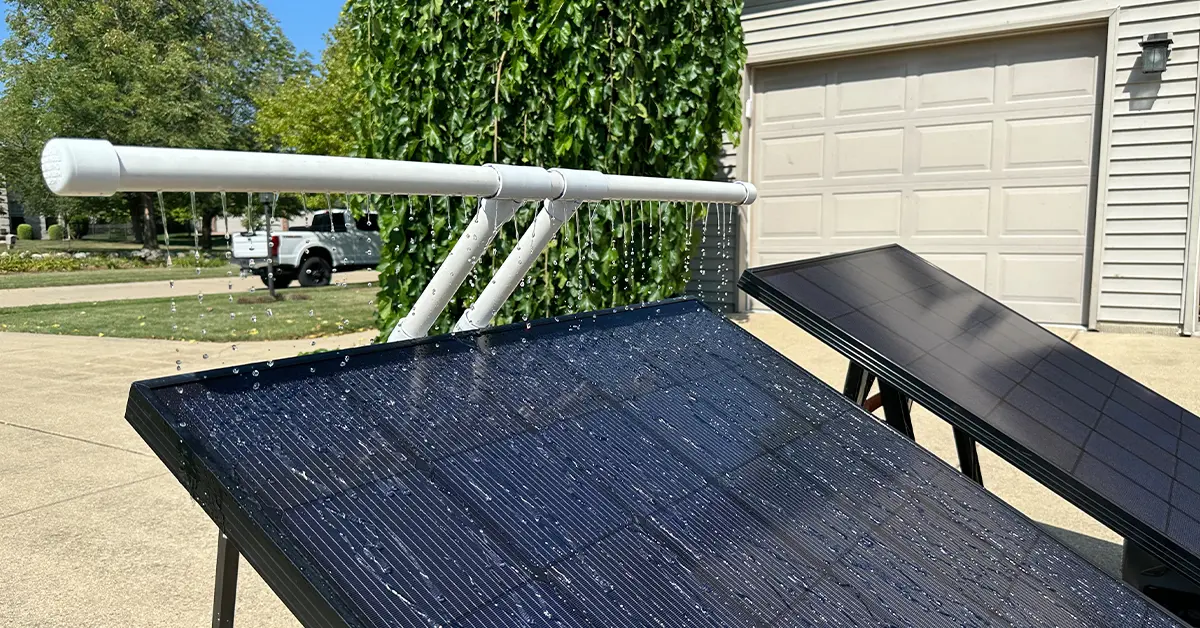Today, it’s scorching hot with temperatures hitting 95°F, which makes it the perfect day for an experiment: cooling solar panels with water to boost efficiency.
This idea came from a comment on one of my YouTube videos, which claimed you can increase solar power output by 10% just by sprinkling water on the panels. So, I decided to test out this theory.
In this article, we’ll test two panels side-by-side to get actual numbers of the power output. You might also be wondering—is this a practical solution for boosting efficiency? We’ll address this question after our findings.
Rather watch than read? Check out this 10-minute video.
Setting a Baseline on Our Panels
Before we dive into the cooling experiment, let’s establish a baseline to ensure our measurements are accurate.
I’ve been running a baseline test using two 360W solar panels, each connected to an EcoFlow Delta Pro. The aim here is to ensure that the power analyzers on both sides produce consistent results.
And the good news is, they do. Both power analyzers have reported an impressive 370 watt hours. This consistency gives us confidence in our measurements, setting the stage for a fair comparison.

Understanding the Temperature Coefficient
To understand the significance of cooling our panels, we must grasp the concept of the temperature coefficient.
Solar panels have specific characteristics, and one of them is the temperature coefficient. This coefficient represents the power loss that occurs as the temperature of the panel’s surface rises above standard test conditions (STC), typically 25°C or 77°F.
For every degree Celsius above STC, panels can lose up to 0.3% of their power output. Converting this to Fahrenheit, it’s about 0.17% power loss per degree Fahrenheit above STC.
Now, with the scorching 95°F air temperature we have today, our panels’ surface temperatures are around 135°F! That’s a significant difference, and according to the temperature coefficient, it suggests we’re looking at around 10% power loss due to the temperature.

The Experiment: Cooling a Solar Panel
With the baseline and temperature coefficient in mind, it’s time to put together a rig for our cooling experiment.
I’m using a simple setup with schedule 40 PVC pipes to create a 39-inch wide sprayer bar. This bar will distribute water evenly across one of the panels, effectively cooling it down. The design is straightforward since it only needs to withstand the duration of the test.

The setup includes an on/off valve for the hose, a flow meter to monitor water usage, and a crossbar with evenly spaced holes to ensure uniform water distribution across the panel’s surface.
Testing the Sprayer Bar
Before we start the experiment, we need to ensure that our sprayer bar works as intended.
By turning on the water flow, we can observe the distribution, making sure it covers the entire width of the panel. A quick check to ensure that all streams are hitting their mark and we’re good to go.

Running the Experiment
With our setup ready, we’re all set to initiate the test. The conditions are perfect—a blazing sun and a scorching day. We’ll let the water run for a reasonable duration to gather accurate data.
After an hour of run time, we’re ready to compare the results. The uncooled side maintains a scorching 135°F, while the cooled-down panel is at a refreshing 75°F.

Now, let’s look at the numbers. The uncooled panel only managed 392 watt-hours, while the cooled panel generated 412 watt-hours. That’s a 20 watt-hour difference, which translates to a 5% power gain for the cooled panel. Not bad!

The Practicality of Cooling Solar Panels with Water
While a 5% power gain is promising, we should also consider the practicality of this cooling method.
In our test, we used approximately 130 gallons of water over the course of the experiment, which equates to about 1.6 gallons per minute.
Is this practical for everyday use? Probably not. While it’s fascinating to see that cooling can yield positive results, the water consumption might not justify the gain for most solar panel setups.
However, there are more efficient methods of cooling, such as systems with internal cooling passages or misting systems. These could potentially offer better results with lower water consumption.
Considering Solar for Your Home
Before we wrap up, if you’re considering solar for your home, it’s crucial to determine the right system size to offset your monthly energy costs. A great place to start is SolarReviews, where you can get an estimate of your system’s size and cost.
If you decide to move forward, you’ll also get to look at installers to ensure they have a solid reputation, so you can have peace of mind during the warranty period.
Final Thoughts
In conclusion, our experiment showed that cooling solar panels can lead to a 5% increase in power output, mitigating the effects of the temperature coefficient.
While this is an interesting finding, the practicality and water consumption associated with this method may not make it the go-to solution for most solar panel setups.
Remember that there are more efficient cooling methods available, which might be better suited for long-term use. So, if you’re thinking of implementing cooling for your solar panels, it’s worth exploring alternative and more sustainable options.
Thanks for joining me on this solar experiment! If you’re interested in other solar-related topics or have any questions, feel free to drop a comment or check out our other articles.

